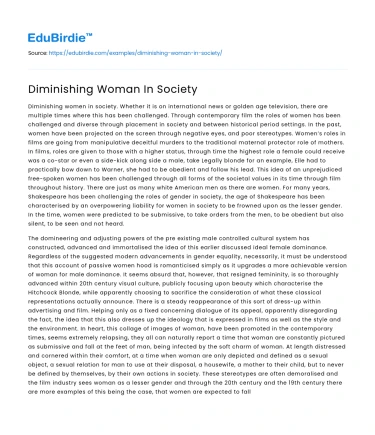Diminishing women in society. Whether it is on international news or golden age television, there are multiple times where this has been challenged. Through contemporary film the roles of women has been challenged and diverse through placement in society and between historical period settings. In the past, women have been projected on the screen through negative eyes, and poor stereotypes. Women’s roles in films are going from manipulative deceitful murders to the traditional maternal protector role of mothers. In films, roles are given to those with a higher status, through time the highest role a female could receive was a co-star or even a side-kick along side a male, take Legally blonde for an example, Elle had to practically bow down to Warner, she had to be obedient and follow his lead. This idea of an unprejudiced free-spoken women has been challenged through all forms of the societal values in its time through film throughout history. There are just as many white American men as there are women. For many years, Shakespeare has been challenging the roles of gender in society, the age of Shakespeare has been characterised by an overpowering liability for women in society to be frowned upon as the lesser gender. In the time, women were predicted to be submissive, to take orders from the men, to be obedient but also silent, to be seen and not heard.
The domineering and adjusting powers of the pre existing male controlled cultural system has constructed, advanced and immortalised the idea of this earlier discussed ideal female dominance. Regardless of the suggested modern advancements in gender equality, necessarily, it must be understood that this account of passive women hood is romanticised simply as it upgrades a more achievable version of woman for male dominance. It seems absurd that, however, that resigned femininity, is so thoroughly advanced within 20th century visual culture, publicly focusing upon beauty which characterise the Hitchcock Blonde, while apparently choosing to sacrifice the consideration of what these classical representations actually announce. There is a steady reappearance of this sort of dress-up within advertising and film. Helping only as a fixed concerning dialogue of its appeal, apparently disregarding the fact, the idea that this also dresses up the ideology that is expressed in films as well as the style and the environment. In heart, this collage of images of woman, have been promoted in the contemporary times, seems extremely relapsing, they all can naturally report a time that woman are constantly pictured as submissive and fall at the feet of man, being infected by the soft charm of woman. At length distressed and cornered within their comfort, at a time when woman are only depicted and defined as a sexual object, a sexual relation for man to use at their disposal, a housewife, a mother to their child, but to never be defined by themselves, by their own actions in society. These stereotypes are often demoralised and the film industry sees woman as a lesser gender and through the 20th century and the 19th century there are more examples of this being the case, that women are expected to fall at the feet of men. Marvel is a prime example of this being the case. Marvel’s new movie, Captain Marvel is a perfect example that proves women from the 19th century compared to the 20th century, either have power over men or are equal.
Save your time!
We can take care of your essay
- Proper editing and formatting
- Free revision, title page, and bibliography
- Flexible prices and money-back guarantee
This complete contrast of men in films has been portrayed by the male figure in films over contemporary times, as taken from the early years of the film business and industry, comparing it to today in the 20th century, there has been a great variation to gender representations. Society has shifted a lot from the older films to the environment we live, the 20th century, which women are seen as equals. This has been less noticeable through a more liberated time for women in the film business, which has been pre-dated in comparison to females position is society. Yet this is not a proper formal representation of the social realm and realism of the historical and present times we live in. When society compares this with the representations of male in film, its been highly noticeable. Men’s role in films come from the stereotype that men are of a higher power and role its quite stable and steady. Which includes examples from past films where the male roles are constantly being thrust into the front where the representation of men is seen to have leadership qualities. In the 20th century, there exists a regular agreement that gender disproportion is the past, it has been a huge problem of the past, of the long erased age.
Reality remains that, the progression has certainly made a positive outlook for woman and femininity under the government and film industries, especially under the patriarchy. Over the years, the progress for better roles and equality for female, have been gravely overvalued by film industry, business. Allowing the pretence of identity and emotional displays of gender equality in work environment, permitting this belief in sizable developments. Using an example, which seems woman may now have a better more substantial position amongst the workforce, the fact still remains that, behind all those footers, news titles, headers and head lines the issue remains, near the equality of participation, the major differences in the pay of women and the employment conditions, compared to men in the film industry. Eventually featuring the fragments of this entrenched belief in a gender pecking order, of apathy and authority.






 Stuck on your essay?
Stuck on your essay?

